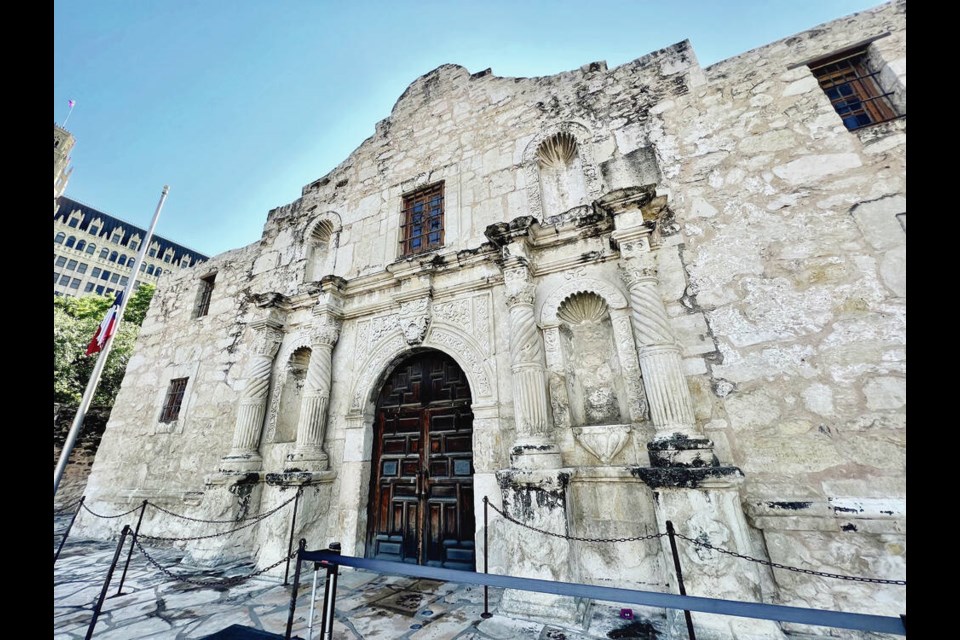Who hasn’t heard the saying “Remember the Alamo.”
The Alamo, in the heart of downtown San Antonio, Texas, was the site of a 13-day battle in 1836, when 189 Texan settlers and volunteers were outgunned by more than 1,500 Mexican soldiers.
Less than two months later cries of “Remember the Alamo” were heard during the final battle of the Texas Revolution.
The Alamo, a symbol of Texas independence from Mexico nearly two centuries ago, remains synonymous with south Texas and is the Lone Star state’s top tourist attraction.
While in San Antonio recently for a conference, I made time to visit the Alamo and was surprised by its small size, given the enormity of the its legacy as a defining moment in Texas history.
Today, only two original buildings stand — the most famous being the limestone Spanish chapel, also known as the Shrine of Texas Liberty, and the other is the more than 300-year-old Long Barrack, which once served as the living quarters and offices of Spanish missionaries.
A $500-million (US) restoration is underway to preserve the existing buildings and reclaim the original 4.5-acre mission site, battlefield footprint, and to build a new Visitor Centre and Museum.
The Alamo was built originally as the first of five missions by Spanish Catholic missionaries, along the San Antonio river in the early 1700s, before it became a frontier outpost.
Although I knew some Alamo history (thanks in part to the 1960 John Wayne movie The Alamo), there’s nothing better than visiting the actual site to gain a better understanding.
Helping bring history to light is a new exhibition hall that opened last spring, displaying a portion of British rock star Phil Collins’ Alamo collection.
The Genesis frontman, fascinated since age five with the story of the Alamo and the adventures of Davy Crockett, began amassing artifacts connected to the Alamo in the early 1990s. (Crockett, an American folk legend, was one of the leaders who tried to defend the Alamo against the Mexican army and was killed in the battle.)
In 2014, Collins donated his entire collection of more than 400 Alamo artifacts, weapons, original documents and relics to the people of Texas, and was made an honorary Texan. The full collection will eventually be placed in the proposed Visitor Center and Museum, expected to open in 2027, but visitors today can see 50 items from the collection, such as the leather pouch owned by Crockett, in the new 24,000-square-foot Alamo exhibition hall behind the chapel.
The remains of Crockett are believed to be in a tomb at the nearby San Fernando Cathedral — the oldest standing church in Texas, dating back 285 years. The cathedral is also worth visiting, to not only pay homage to some of the Alamo leaders, but to see the light show called The Saga. This 24-minute, 3D light show, projected on the cathedral’s ancient walls tells San Antonio’s rich history. The show happens every Tuesday, Friday, Saturday and Sunday evening at 9 p.m., 9:30 and 10 p.m.
Both the Alamo and The Saga show are free, but advanced tickets are required to enter the Alamo’s Spanish Chapel.
Also free are admissions to the four other missions, established by the Franciscan missionaries, which together are a UNESCO World Heritage Site — the only UNESCO site in Texas. They are Missions Concepcion, San Jose, San Juan, and Espada, that all preserved and maintained by the The National Park Service through an agreement with the Archdiocese of San Antonio and the state of Texas. (The Alamo was established in 1718 as Mission San Antonio de Valero, but is maintained as a memorial to Texas independence.)
Besides visiting the Alamo, I also toured the Mission San Jose, just a 15-minute drive from downtown. This active parish, which still holds Sunday mass in the church, was once a fortified village that also had a farm and ranch, and provided housing for the indigenous people who were converted to Catholicism and taught to live as Spaniards by the Franciscan friars.
“We meet regularly with mission descendants,” said Paul Lathrop, chief of interpretation and education for the San Antonio Missions National Historical Park. “What happened to these people is they became San Antonians. They are everywhere in this neighbourhood in particular. They speak a different language and many of them have a different religion than they did 300 years ago but they’re still here.”
San Antonio is indeed a blend of many cultures, including indigenous people, Mexican Indians, Spanish settlers and German immigrants, who give this vibrant city a distinct flavour, particularly when it comes to local food.
From Tex-Mex and authentic Mexican food to German schnitzel, the local food culture is all about down home cooking with traditional, simple food prepared with flavourful spices and seasonings. Great food can be found everywhere from simple cantinas to upscale restaurants. (One of my favourite meals was vegetarian tacos from a food truck parked outside the San Fernando Cathedral).
It’s no surprise the city was named a Creative City of Gastronomy by UNESCO in 2017 (only one of two U.S. cities to get the designation).
Another of San Antonio’s top tourist attractions is the River Walk, which is lined with restaurants, hotels, bars, shops and even museums, like the San Antonio Museum of Art downtown.
This 24-km network of walkways, just below street level along the San Antonio River, allows visitors a different way to explore the city. I would walk its pathway and over bridges to get to the convention centre since my hotel, The Hyatt Regency San Antonio, was conveniently located on the River Walk, near the Alamo.
I also took the 35-minute guided tour of the River Walk, the 5.5-km downtown centre loop on a pink, electric river barge, with GO RIO but you can also buy a ticket for a hop-on, hop-off experience, to travel at your leisure, visiting the 15 stops along the river.



